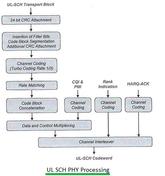LTE NB-IoT NPUSCH: Format-1 vs Format-2
Advertisement
This page describes the LTE NB-IoT NPUSCH (Narrowband Physical Uplink Shared Channel) function, its location, and basics with respect to the LTE-NB IoT Standard. It covers NB-IoT NPUSCH formats and highlights the difference between NPUSCH format-1 and NPUSCH format-2.
Function: The NPUSCH channel is used to transport uplink user data and control information from upper layers. Moreover, NPUSCH carries HARQ-ACK (Hybrid Automatic Repeat Request - Acknowledgement) for NPDSCH (Narrowband Physical Downlink Shared Channel). NB-IoT uses only one PRB (Physical Resource Block) as the maximum device scheduled bandwidth.
Table-1 shows useful parameters related to the NB-IoT NPUSCH channel.
| NPUSCH information | Value |
|---|---|
| Subframe | Any |
| RU | 1, 2, 4, 8, 32 ms |
| Repetitions | 1, 2, 4, 8, 16, 32, 64, 128 |
| Subcarrier spacing | 3.75 KHz, 15 KHz |
| Bandwidth | 3.75, 15, 45, 90, 180 KHz |
| Carrier | Any |
Difference between NB-IoT NPUSCH Format-1 and Format-2
NPUSCH supports two transmission formats depending on the data it carries: format-1 and format-2. Let’s understand the differences between them.
NPUSCH Format-1

- Format-1 is used for carrying uplink data and uses the same LTE turbo code for error correction.
- It supports UE (User Equipment) bandwidth allocation smaller than one PRB, whereas LTE has a minimum bandwidth allocation of 1 PRB.
- The maximum transport block (TB) size is 1000 bits.
- It supports multi-tone transmission based on LTE numerology. Here, NB-IoT UE is allocated with 3 and 6 tone formats.
- It also supports single-tone transmission based on either 3.75 KHz or 15 KHz numerology. LTE uses only 15 KHz.
- It uses π/2 - BPSK or π/4 - QPSK for single-tone transmission to reduce PAPR (Peak-to-Average Power Ratio).
- It supports single-layer transmission, whereas LTE supports multiple spatial multiplexing layers.
- It uses the same slot structure as legacy PUSCH with 7 OFDM symbols per slot (as shown in the figure above) and the middle symbol as DMRS (Demodulation Reference Signal) used for channel estimation.
NPUSCH Format-2

- It is used for signaling HARQ-ACK for NPDSCH.
- It uses repetition code for error correction.
- NPUSCH format-2 has 7 OFDM symbols per slot as shown in the figure above.
- It supports 3.75 KHz or 15 KHz numerology.
- It uses the middle three symbols as DMRS used for channel estimation.
- It uses single-tone transmission.
Reference: 3GPP 36 series LTE
Advertisement
 RF
RF



